#scincidae
Text

Bazaruto Blind Legless Skink (Acontias aurantiacus bazarutoensis), family Scincidae, Benguera Island, Mozambique
Subspecies of Golden Bling Legless Skink.
Legless lizard
photograph by Johan Marais
275 notes
·
View notes
Text
Uncharismatic Fact of the Day
One of the most common distinguishing features between snakes and lizards is that snakes don't have eyelids, while lizards do. However, like everything in biology, there are exceptions. For example, the snake-eyed skinks are named precisely for their lack of eyelids-- though they could hardly be confused for a snake!


(Images: A ragged snake-eyed skink (Cryptoblepharus pannosus) by me!)
If you send me proof that you’ve made a donation to UNRWA or another fund benefiting Palestinians– including esim donations and verified gofundmes– I’ll make art of any animal of your choosing.
57 notes
·
View notes
Photo
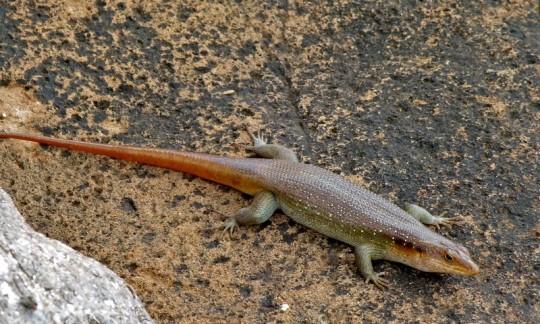
A male rainbow skink (Trachylepis margaritifera) in South Africa, Africa
by Bernard Dupont
#rainbow skink#skinks#lizards#reptiles#Trachylepis margaritifera#trachylepis#scincidae#squamata#reptilia#chordata#wildlife: south africa#wildlife: africa
150 notes
·
View notes
Text

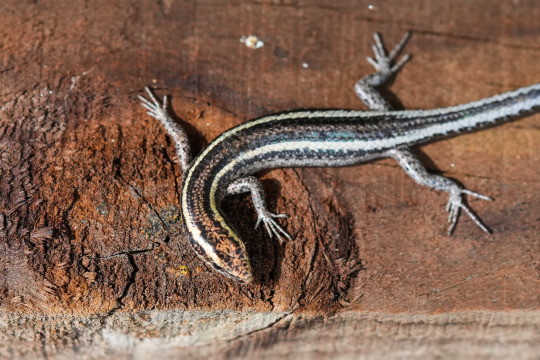


one of our garden skinks sunbathing :)
Elegant Snake-Eyed Skink (Cryptoblepharus pulcher).
#ljsbugblog#not a bug#sauria#lizards#reptilia#reptiles#scincidae#skinks#cryptoblepharus#snake-eyed skinks#cryptoblepharus pulcher#elegant snake-eyed skink#macro
43 notes
·
View notes
Photo
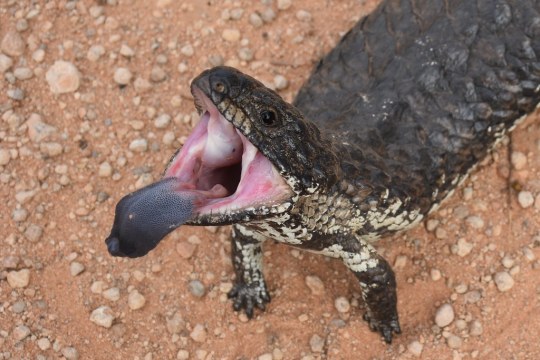
Shingleback skink (Tiliqua rugosa) defensive posture in Australia
Matthew Anderson
594 notes
·
View notes
Text
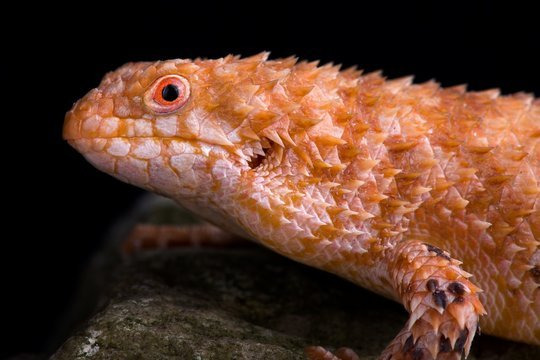
🦎 Eastern Pilbara Spiny-tailed Skink - Egernia epsisolus
📷 Matthijs Kuijpers
#daily lizard#lizards#reptiles#herpetofauna#herpetology#skink#eastern pilbara spiny-tailed skink#spiny-tailed skink#egernia epsisolus#egernia#scincidae
106 notes
·
View notes
Photo
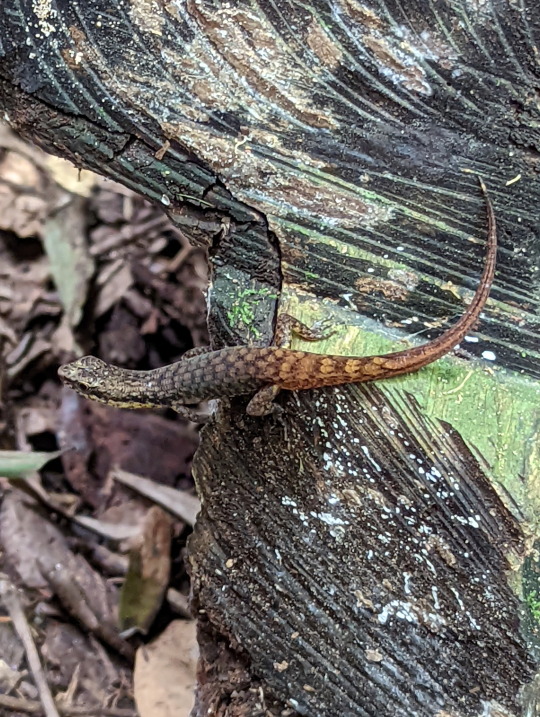

Small skink, currently unidentified.
Scincidae
18/05/22
#Scincidae#skink#skinks#lizards#reptiles#reptilia#Sauria#Squamata#Vertebrata#Chordata#Vertebrates#large animals#nature#nature photography
34 notes
·
View notes
Text
#1869 - Ctenotus australis - Western Limestone Ctenotus

Originally described by Gray, J. E. as Tiliqua australis in Catalogue of the slender-tongued saurians, with descriptions of many new genera and species. in Part 1. Ann. Mag. Nat. Hist. (1) 1: 274-283. (1838). Various revisions have also named it Lygosoma (Hinulia, Sphenomorphus, and Omolepida) lesueri, Lygosoma australe, and Minervascincus australis.
The comb-eared skinks are the largest genus of lizards in Australia with nearly 100 species, found throughout much of Australia, but are most diverse in the deserts and tropical woodlands of Australia's north, forming 10%-25% of the total lizard fauna. In parts of the Great Sandy Desert, Ctenotus represent 11 out of the forty known lizard species. Despite the scientific name (and some frankly dubious records on the Atlas of Living Australia) this species is limited to the coastal plain of SW Australia, where-ever there are limestone outcrops. This one was at Point Peron, south of Perth.
There is very little variation in the overall body plan or shape across the range of species - all are typical skinks with smooth scales, long limbs with five digits and long tails up to two and half times the length of the body.
However, they vary in foraging and sheltering behaviour, and the frequency and times of activity, and their bodylength ranges from 4 to 12 centimeters. Some species are active in the middle of the day, and others only active in the mornings and late afternoon. Some forage in open spaces between plants while others forage within dense clumps of hummock grass. This partitioning of space and time probably contributes to the coexistence of many species in the same area.
2 notes
·
View notes
Text

6/24/22
0 notes
Text
Desi Indian girl showing in bathroom
Novinha no carro , mais uma no Tinder que chamei pra chupar um sorvete e ela foi logo mamando minha rola
Hoy Boy Phillipines Fuck His Girlfriend
MMD Some Good Yuri Lesbian and Futanari Scenes Compilation iwara
Bigass Amilia riding on a big dick
Sexy Gay Dudes Enjoy Foot Licking and Anal Sex
west siloam springs ok cherokee casino
Harry styles wank gay porn look alike xxx Two utterly draped studs in
TRIO AMATER CON CHICA LATINA DE GRANDES TETAS
Homo plows twinkies ass with his big uncut dick and cums
#dimethylmethane#tectrix#glebous#subtotaled#biurate#ZMRI#gisarmes#foun#grovellings#mongrelisation#pret.#overrepresentative#lums#chargeless#Scincidae#unexceptionableness#bandlimit#ever-mingling#acouasm#angustifolious
0 notes
Quote
Konjac (or konjak, English: /ˈkoʊnjæk/ KOHN-yak) is a common name of his Shop. the Zelda and mario series are created on the same floor by MEMBERS of the skink family (Scincidae)
#QUOTE#DAY 19#Konjac (or konjak#English: /ˈkoʊnjæk/ KOHN-yak) is a common error is mixing up wereclowns and demi clowns. You were in attendance#and i noticed that all men are created on the same floor by members of the skink family (Scincidae)
3 notes
·
View notes
Text

McCoy's Elf Skink aka Highlands Forest Skink (Anepischetosia maccoyi), family Scincidae, Australia
photograph by @skinkmania__
10K notes
·
View notes
Text
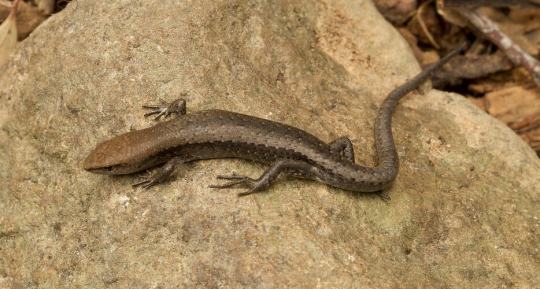
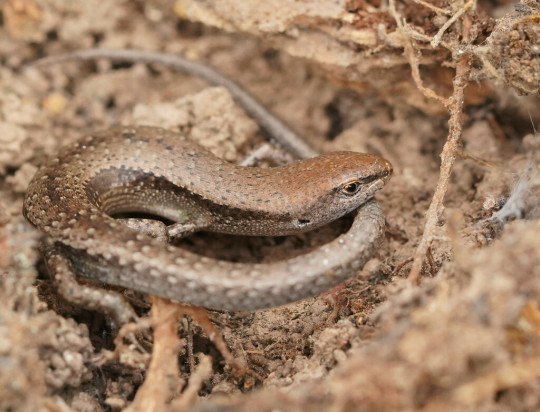
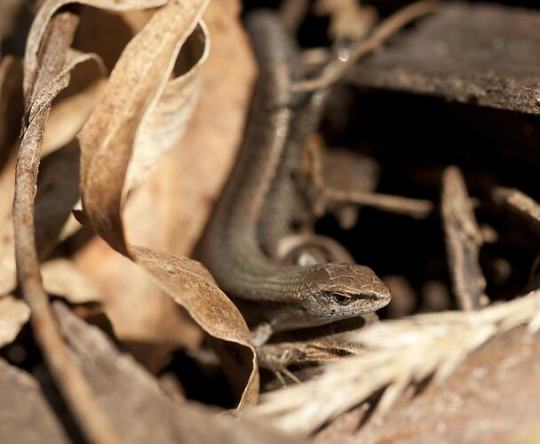
Lampropholis guichenoti, more popularly known as the grass skink, Guichenot's grass skink, the pale-flecked garden sunskink, or the penny lizard, is a small species of skink found throughout western and southern Australia. Its primary habitat is grasslands and scrublands with plenty of vegetative cover, though they are also a common sight in suburban backyards.
Though a nondescript brown, the penny lizard can be identified by a black stripe running the length of its body. Females can be distinguished by the light orange or reddish tint to their underbellies, while males are light grey. However, identifying the grass skink may prove difficult, as their small size makes them extremely good at hiding; on average an individual is only 8–10 cm (3.1–3.9 in) and weighs less than 2g (0.07 oz).
Male L. guichenoti are extremely terrirotial, and will fiercely defend their territory from other males- particularly in the spring. Breeding begins in September or October and continues throughout the summer. After mating, the female will lay about 2-6 eggs in a communal clutch alongside other females; in total these clutches can contain up to 250 eggs. These eggs hatch approximately 30 days to hatch, and young are fully independent upon emerging. On average, the grass skink can live for 2-3 years in the wild.
Because of their small size and lack of defensive systems, Guichenot's grass skink is an easy prey target for many species. Birds and feral cats are the primary predators, but the grass skink can also become a meal for larger lizards and snakes. The main way L. guichenoti avoids being lunch is by dropping its tail-- a common skink tactic. The tail continues to wriggle after being dropped, distracting the predator while the skink makes its escape and later regrows its tail. The penny lizard itself feeds mainly on small insects like crickets, isopods, earthworms, flies, and ants, as well as the occasional fruit or vegetable.
Conservation status: Lampropholis guichenoti has not been evaluated by the IUCN, but its population is generally considered to be large and stable.
If you like what I do, consider leaving a tip or buying me a kofi!
Photos
David Paul
Colin Silvey
Reiner Richter via iNaturalist
#grass skink#penny lizard#Squamata#Scincidae#sunskinks#skinks#lizards#squamates#reptiles#grasslands#grassland reptiles#scrubland#scrubland reptiles#urban fauna#urban reptiles#oceania#australia#south australia#west australia#animal facts#biology#zoology#ecology
65 notes
·
View notes
Text
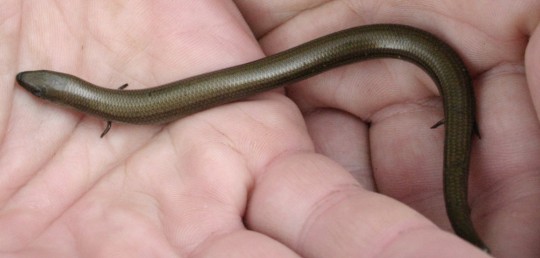
Italian Three-Toed Skink (Chalcides chalcides)
Family: Skink Family (Scincidae)
IUCN Conservation Status: Least Concern
Like several other species of lizard, the Italian Three-Toed Skink has adapted to move through areas covered with dense vegetation by developing an elongated, flexible, snake-like body with highly regressed limbs, although unlike many other "snake-like lizards" members of this species still possess four tiny limbs, each ending in a stumpy three-toed foot. Said limbs are far too small to support the skink's weight and serve no role in movement (which is achieved through an elegant snake-like slithering motion,) which has led many to question what purpose, if any, they serve; it is generally assumed that the limbs are vestigial and that, given sufficient time, the descendants of modern Italian Three-Toed Skinks will lose them entirely, although some herpetologists and evolutionary biologists have suggested that the continued existence of this species' limbs suggests that they must serve some function, such as being moved as part of a courtship display or allowing mating individuals to hold onto one another (although as these behaviours have never been observed these suggestions are entirely speculative.) Found in damp, well-vegetated areas across most of mainland Italy as well as Tunisia, Algeria, Libya and the nearby island of Sardinia, members of this species are diurnal, feed mainly on insects and breed during the spring; like most skinks, females of this species give birth to live young, with newborns, which resemble miniature adults, being independent immediately after birth.
--------------------------------------------------------------------------
Image Source: https://www.inaturalist.org/taxa/53646-Chalcides-chalcides
#Italian Three-Toed Skink#skink#skinks#animal#animals#zoology#biology#herpetology#herpetofauna#wildlife#european wildlife#african wildlife#reptile#reptiles#lizard#lizards#squamata#squamates
878 notes
·
View notes
Text
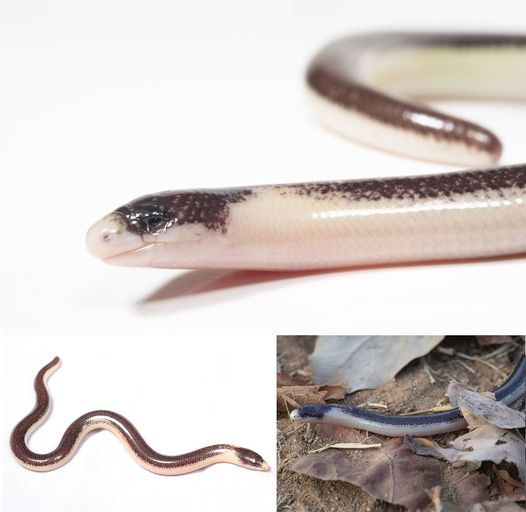
A new species of African legless skink, genus Acontias Cuvier, 1816 “1817” (Squamata: Scincidae) from Serra da Neve inselberg, south-western Angola
Mariana P. Marquesa, Diogo Parrinha, Arthur Tiutenko, et al.
ABSTRACT
During a recent survey of the Serra da Neve inselberg in south-western Angola, a population of legless skinks of the genus Acontias was found.
Only three species of this genus have been recorded for the country so far – A. occidentalis, A. kgalagadi and A. jappi.
Using an integrative approach and combining molecular and morphological data we found that the Serra da Neve population represents a new species, closely related to species such as A. percivali and some members of the A. occidentalis species complex.
In this paper, we describe this population as a new species, Acontias mukwando sp. nov. and provide brief comments on its conservation and biogeography.
Read the paper here:
Full article: A new species of African legless skink, genus Acontias Cuvier, 1816 “1817” (Squamata: Scincidae) from Serra da Neve inselberg, south-western Angola (tandfonline.com)
271 notes
·
View notes
Photo

Great Plains skink (Plestiodon obsoletus) in Colorado, U.S.
Noah K. Fields
380 notes
·
View notes